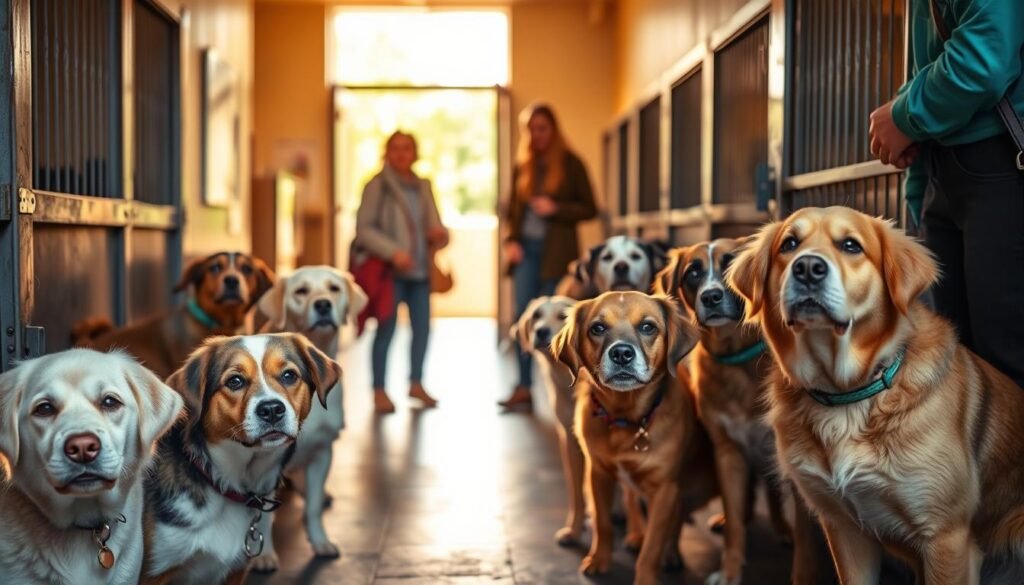Cheapest Dog Breeds: Affordable Pets for Your Family
Table of Contents
Getting a new furry friend is exciting, but think about the costs. The ASPCA says owning a dog can cost between $1,400 and $4,300 a year.
But, you don’t need to spend a lot to have a lovable pet. Choosing affordable dog breeds can save you money. This way, you still get the joy and love they offer.
Some budget-friendly dog breeds are also great for families. Looking into these options can help you find a pet that’s right for your budget.
Understanding the True Cost of Dog Ownership
It’s key for those thinking of getting a dog to know the real cost. The first step, buying or adopting a dog, is just the start. It leads to a big financial promise for years to come.
The first year with a dog can cost about $3,221. Later years might cost between $1,391 and $1,149. This depends on the dog’s size, age, and health. It shows how vital it is to think about lifetime expenses like food, grooming, and vet bills.
Initial Costs vs. Lifetime Expenses
First costs, like adoption fees, are just the beginning. But, lifetime costs can really affect your budget over the dog’s life.
| Expense Category | First Year | Subsequent Years |
|---|---|---|
| Food and Treats | $500-$700 | $500-$700 |
| Veterinary Care | $200-$500 | $100-$300 |
| Grooming | $30-$300 | $30-$300 |
What Makes a Dog Breed “Affordable”
An affordable dog breed has lower costs for food, grooming, and vet care. Breeds with fewer health issues and less grooming needs are cheaper.
Factors That Influence the Cost of a Dog
Several key elements contribute to the overall expense of dog ownership. This makes some breeds more affordable than others. Understanding these factors affecting dog costs is crucial for prospective dog owners.
Breed Popularity and Rarity
The popularity and rarity of a breed can significantly impact its initial purchase price. Rarer breeds often come with a higher price tag. This is due to their uniqueness and the challenges associated with breeding them.
Size and Lifespan Considerations
The size of the dog is another critical factor. Larger dogs consume more food and require more costly supplies. This increases ongoing expenses. Additionally, a breed’s average lifespan can influence the total cost of ownership. With longer-lived breeds, you may incur more expenses over their lifetime.
Health Predispositions
Some breeds are predisposed to specific health issues. This can lead to higher veterinary bills. For instance, breeds with fewer hereditary health issues tend to have lower vet bills. This makes them more cost-effective in the long run. Understanding a breed’s health predispositions can help you anticipate and prepare for potential medical expenses.
By considering these factors, you can make an informed decision. Choose a breed that fits your budget and meets your family’s needs.
The Cheapest Dog Breeds for Budget-Conscious Families
Even on a tight budget, you can still get the perfect dog. Many breeds are affordable, fitting different family needs. They come in various sizes and personalities.
Beagle ($500-$1,500)
Beagles are loved for their friendly and curious nature. They are small, active dogs that need lots of exercise.
Temperament and Care Requirements
Beagles are excellent with kids and easy to care for. But, they need regular grooming and exercise to stay healthy.
Long-term Cost Considerations
Beagles cost around $1,000 to $1,500 a year. This includes vet visits, shots, and health issues like hip dysplasia.
Chihuahua ($300-$800)
Chihuahuas are tiny but very loyal to their owners.
Temperament and Care Requirements
Chihuahuas are energetic and need some exercise. They don’t need much grooming but can get sick if not cared for right.
Long-term Cost Considerations
Chihuahuas are cheap to start but can get expensive with health problems like hypoglycemia and dental issues.
Rat Terrier ($350-$700)
Rat Terriers are smart and active, easy to train.
Temperament and Care Requirements
Rat Terriers are loving and great with families. They need exercise and mental games to stay happy.
Long-term Cost Considerations
Rat Terriers are mostly healthy but can get sick. Regular vet visits and a good diet help keep costs down.
Mixed Breeds and Shelter Dogs ($50-$300)
Adopting a mixed breed or shelter dog is affordable and rewarding.
Benefits of Adopting Mixed Breeds
Mixed breeds might be healthier due to hybrid vigor. Adoption fees are lower than buying from a breeder.
Health Considerations for Mixed Breeds
Even though mixed breeds are healthier, they can still have health issues. Regular vet visits are key.
Adopting a dog from a shelter can save up to 90%. Adoption fees range from $50 to $500. Here’s a comparison of the initial costs for the breeds mentioned:
| Breed | Initial Cost | Annual Cost |
|---|---|---|
| Beagle | $500-$1,500 | $1,000-$1,500 |
| Chihuahua | $300-$800 | $500-$1,000 |
| Rat Terrier | $350-$700 | $800-$1,200 |
| Mixed Breeds/Shelter Dogs | $50-$300 | $500-$1,000 |
Small Affordable Dog Breeds: Perfect for Apartment Living
Apartment dwellers have good news. There are many small dog breeds that are affordable and fit well in small spaces. These dogs are great companions for city living without needing a big yard.
Jack Russell Terrier ($800-$1,500)
The Jack Russell Terrier is full of energy and loves to move. They do well with short walks or playtime inside. Their small size and low cost make them perfect for apartments.
Italian Greyhound ($1,000-$2,000)
Italian Greyhounds are athletic but also love to relax. They’re quiet, gentle, and affectionate. They’re great for apartment living with little exercise needed.
Miniature Pinscher ($500-$900)
The Miniature Pinscher is small, energetic, and curious. They need daily walks and playtime to be happy. Their size means they cost less to feed and supply.
Cost-Saving Benefits of Small Breeds
Small dog breeds are cost-effective. Here are some key benefits:
- Lower Food Costs: Small breeds eat less, saving money on dog food over time.
- Reduced Supply Costs: They need smaller, less expensive supplies like toys and bedding.
- Less Space, Less Damage: Their small size means less chance of damage to your apartment, saving on repairs.
Small dog breeds like the Jack Russell Terrier, Italian Greyhound, and Miniature Pinscher are wonderful companions. They’re affordable and perfect for apartment living.
Medium-Sized Economical Dog Breeds for Active Families
Active families can find a loyal companion in medium-sized dog breeds. These breeds are both economical and energetic. They offer a perfect balance between companionship and exercise, making them ideal for families who enjoy outdoor activities.
Border Collie Mix ($300-$600)
The Border Collie Mix is a highly intelligent and energetic breed. They thrive on activity. With a moderate size, they require regular exercise but are generally healthy, making them a cost-effective choice for active families.
Australian Cattle Dog ($400-$800)
Australian Cattle Dogs are known for their robustness and intelligence. They are relatively affordable. They have a moderate energy level, requiring regular exercise to stay happy and healthy.
Whippet ($800-$1,500)
Whippets are sleek, athletic dogs that are surprisingly laid-back indoors. Despite their athletic ability, they don’t require as much exercise as one might think. This makes them a great choice for families with a moderate activity level.
Balancing Activity Needs with Budget Constraints
When choosing a medium-sized dog breed, it’s essential to balance their activity needs with your budget. Regular exercise and mental stimulation are crucial. But so are the costs associated with maintaining an active lifestyle for your dog.
| Breed | Initial Cost | Exercise Needs | Health Considerations |
|---|---|---|---|
| Border Collie Mix | $300-$600 | High | Generally healthy |
| Australian Cattle Dog | $400-$800 | Moderate to High | Prone to deafness and blindness |
| Whippet | $800-$1,500 | Moderate | Susceptible to heart issues |
By understanding the needs and costs associated with these breeds, you can make an informed decision. This decision will suit your family’s lifestyle and budget.
Low-Maintenance Dog Breeds That Won’t Break the Bank
Low-maintenance dog breeds are great for those who want a pet but don’t want to spend a lot. They’re perfect for busy people or anyone who likes a simple pet care routine.
Basenji: The “Barkless” Dog
The Basenji is special because it doesn’t bark. This makes it great for people living in apartments or who prefer a quiet pet. It has a short coat that’s easy to groom, saving money on grooming costs.
Greyhound: The Couch Potato Racer
Greyhounds are fast but love to relax. They have a short, smooth coat that’s easy to take care of. They need regular exercise, but it’s not too much.
Smooth Fox Terrier
The Smooth Fox Terrier is another low-maintenance breed. Its short, dense coat makes grooming simple and affordable. They need regular exercise to stay happy and healthy.
Grooming and Exercise Requirements
When picking a low-maintenance dog, think about grooming and exercise. Breeds like the Basenji and Greyhound have short coats and need little grooming. But, they still need regular exercise to stay healthy.
| Breed | Grooming Needs | Exercise Needs |
|---|---|---|
| Basenji | Low | Moderate |
| Greyhound | Low | Moderate |
| Smooth Fox Terrier | Low | Regular |
Knowing these needs helps you choose the right dog for your lifestyle and budget. By picking a breed with low grooming and the right exercise needs, you can have a dog without spending a lot.

Hidden Costs of Dog Ownership to Consider
Having a dog is more than just the initial cost. There are many hidden expenses to be ready for. The true cost of owning a dog is key to giving your pet the best care.
Emergency Veterinary Care
Medical emergencies can be costly, with vet bills reaching thousands. Accidents or illnesses can strike at any time. It’s important to be ready for these unexpected costs.
Getting pet insurance can help with these expenses. Some plans cover accidents, illnesses, and even routine care. This can make budgeting for your dog’s health easier.
Breed-Specific Health Issues
Some breeds face specific health problems, leading to higher vet bills. For instance, big dogs might get hip dysplasia, while small dogs could have dental issues. Knowing your dog’s breed’s health risks helps you plan for these costs.
Training and Behavioral Intervention
Training and behavior help might be needed for your dog. Professional training can tackle obedience, housebreaking, and behavior issues. The cost depends on the trainer, location, and your dog’s needs.
Boarding and Pet-Sitting Expenses
Traveling means considering boarding or pet-sitting costs. You’ll need to budget for your dog’s care while you’re away. Look into local options and prices to plan for these expenses.
Knowing these potential costs helps you budget better for your dog’s care. This way, you’re ready for any situation that comes up.
Adoption vs. Purchasing: Finding Your Affordable Canine Companion
Thinking about getting a new dog? Choosing between adoption and purchase is a big decision. Adopting from a shelter or rescue can be rewarding. It gives a loving home to a dog in need and might save you money.
Benefits of Shelter Adoption
Adopting from a shelter saves money and helps a dog in need. Shelters often cover initial vet care and microchipping in the adoption fee. The ASPCA says adopting can save you $500 to $1,000 in vet costs.

Rescue Organizations and Breed-Specific Rescues
Rescue groups and breed-specific rescues help dogs find homes. They have many breeds and mixes for adoption. Adopting from a rescue means you’re giving a home to a dog and making room for another.
Questions to Ask Before Adopting
Before adopting, ask important questions. Find out about the dog’s history, temperament, health, and training needs. Knowing these helps ensure a smooth transition for you and your new pet.
Financial Assistance Programs for Pet Owners
Struggling with dog care costs? Financial help is available. The Humane Society offers resources to manage pet care expenses.
| Organization | Services Offered | Cost |
|---|---|---|
| ASPCA | Adoption Services, Veterinary Care | $50-$200 |
| Humane Society | Adoption Services, Training Resources | $30-$150 |
| Local Shelters | Adoption Services, Microchipping | $20-$100 |
Adopting a dog is rewarding and helps reduce shelter numbers. The ASPCA says, “Adopting a pet from a shelter or rescue organization can be a highly rewarding experience, providing a loving home to a deserving animal.”
“Adopting a pet from a shelter or rescue organization can be a highly rewarding experience, providing a loving home to a deserving animal.” – ASPCA
Minimizing Ongoing Costs of Dog Ownership
To keep your furry friend by your side without breaking the bank, it’s essential to minimize the ongoing costs associated with dog ownership. By adopting a few straightforward strategies, you can significantly reduce expenses while ensuring your dog leads a happy, healthy life.
DIY Grooming Tips
One effective way to cut costs is by learning basic DIY grooming techniques. Regular grooming not only keeps your dog clean and comfortable but also helps prevent costly health issues. Simple practices like brushing your dog’s coat, cleaning their ears, and trimming their nails can be done at home with the right tools and a bit of practice.
- Invest in a good quality brush suitable for your dog’s coat type.
- Learn how to trim your dog’s nails safely to avoid costly vet visits.
- Regularly check and clean your dog’s ears to prevent infections.
Preventative Healthcare Strategies
Investing in preventative healthcare can save you money in the long run by reducing the likelihood of costly medical issues. This includes regular vaccinations, parasite control, and dental care.
| Preventative Measure | Cost Savings | Health Benefits |
|---|---|---|
| Regular Vaccinations | Avoids costly treatments for preventable diseases | Protects against serious diseases |
| Parasite Control | Reduces the cost of treating parasite infestations | Prevents discomfort and health issues caused by parasites |
| Dental Care | Minimizes the need for expensive dental procedures | Promotes overall health by preventing dental disease |
Budget-Friendly Feeding Options
Feeding your dog doesn’t have to be expensive. You can save money by opting for budget-friendly dog food that still meets your dog’s nutritional needs. Consider buying dog food in bulk, using coupons, or even preparing homemade dog meals with vet-approved recipes.
Affordable Training Resources
Training is an essential part of dog ownership, but it doesn’t have to break the bank. Utilize affordable training resources such as online tutorials, local community classes, or training books from your library.
By implementing these strategies, you can enjoy dog ownership without the financial stress, ensuring a happy and healthy life for your pet.
Conclusion: Finding the Right Balance Between Cost and Compatibility
Finding a dog breed that fits your budget and lifestyle is key for a great pet experience. You’ve seen how affordable dog breeds and costs can impact your life. Being smart about spending can really help.
When thinking about getting a dog, it’s important to balance cost and compatibility. Picking a breed that’s easy on your wallet and knowing about future costs can make a big difference. Things like size, health, and grooming needs affect how much you’ll spend on your dog.
Looking into adoption is another way to get a loving dog without breaking the bank. Remember, the love and loyalty a dog gives is priceless. With the right choices, you can have a happy pet without hurting your finances. Making smart decisions about dog ownership leads to a happy and healthy home for you and your dog.

